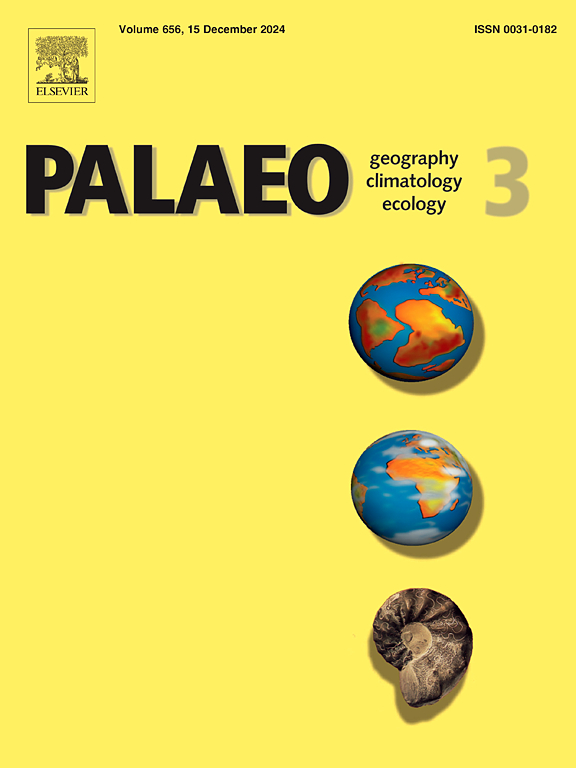Spatial evolution of westerly jets over East Asia since the Last Glacial Maximum: A Mariana Trench record
IF 2.6
2区 地球科学
Q2 GEOGRAPHY, PHYSICAL
Palaeogeography, Palaeoclimatology, Palaeoecology
Pub Date : 2025-07-21
DOI:10.1016/j.palaeo.2025.113162
引用次数: 0
Abstract
Variations in the seasonal south-to-north transition of the westerly jet (WJ) relative to the Tibetan Plateau have been suggested to control the paleoclimate change over Asia. To improve the understanding of variations in the seasonal WJ transition since the Last Glacial Maximum (LGM), we examine the changes in the provenance of Asian dust in the sediments from the southern Mariana Trench using trace element compositions and Sr-Nd isotopic signatures. During the LGM with low Northern Hemisphere summer insolation, the WJ axis remained south of the Tibetan Plateau throughout the year. The southern Mariana Trench received dust from the Taklimakan Desert during most of the LGM period. However, it mainly received dust from the Mongolian Gobi Desert during some periods in the early LGM. We attributed this dust source variation to the increased Northern Hemisphere ice volume and concomitant shrinkage of the area affected by the WJ during the LGM. This dust source variation may also account for higher dust accumulation rates during the early LGM in the North Pacific Ocean than during the late LGM. As the boreal summer insolation decreased after the mid-Holocene, the timing of the seasonal WJ transition was progressively delayed, and the orientation of the jet axis shifted from southwest-northeast to west-east. We emphasize that the spatiotemporal difference in the Asian precipitation since the LGM was closely associated with the variations in the seasonal jet transition.
末次盛冰期以来东亚上空西风急流的空间演化:马里亚纳海沟记录
相对于青藏高原的西风急流(WJ)的季节性南北向转换变化被认为控制着亚洲的古气候变化。为了更好地理解末次极大冰期(LGM)以来季节WJ转换的变化,我们利用微量元素组成和Sr-Nd同位素特征研究了南马里亚纳海沟沉积物中亚洲尘埃的来源变化。在北半球夏季低日照的LGM期间,WJ轴全年保持在青藏高原以南。在LGM时期,南马里亚纳海沟接收了来自塔克拉玛干沙漠的沙尘。然而,在LGM早期的某些时期,它主要接收来自蒙古戈壁沙漠的沙尘。我们将这种沙尘源的变化归因于北半球冰量的增加以及在LGM期间受WJ影响的面积的缩小。这种沙源的变化也可能解释了北太平洋低潮早期沙尘积累率高于低潮后期的原因。全新世中期以后,随着北方夏季日晒的减少,季节WJ转换时间逐渐推迟,急流轴方向由西南-东北向西-东转移。我们强调,LGM以来亚洲降水的时空差异与季节性急流转换的变化密切相关。
本文章由计算机程序翻译,如有差异,请以英文原文为准。
求助全文
约1分钟内获得全文
求助全文
来源期刊
CiteScore
5.90
自引率
10.00%
发文量
398
审稿时长
3.8 months
期刊介绍:
Palaeogeography, Palaeoclimatology, Palaeoecology is an international medium for the publication of high quality and multidisciplinary, original studies and comprehensive reviews in the field of palaeo-environmental geology. The journal aims at bringing together data with global implications from research in the many different disciplines involved in palaeo-environmental investigations.
By cutting across the boundaries of established sciences, it provides an interdisciplinary forum where issues of general interest can be discussed.

 求助内容:
求助内容: 应助结果提醒方式:
应助结果提醒方式:


